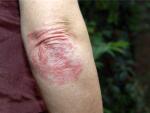
Rashes can appear for different reasons in different areas.
The appearance of a rash may vary based on the underlying cause. Often, rashes appear as:
If you notice a rash appear, it is important to contact your doctor so that they can diagnose the underlying cause. Not all rashes are treatable with over-the-counter (OTC) creams.
There are many possible causes of a rash in your underarm, including the following.
Heat rash
A heat rash is a typically harmless rash that tends to clear up on its own within a few days.
Heat rashes generally happen when you sweat more than you usually would. They are more common in the summer months and in areas that have a hotter climate.
A heat rash typically appears in areas of your body where sweat may collect. These areas include the:
- armpits
- back
- areas under the breasts
- chest
- groin
- elbow creases
- backs of the knees
- waist
Symptoms of a heat rash include:
- small, raised spots
- mild swelling
- an itchy or prickly feeling
A heat rash typically appears as red, but the color may vary or appear brown on dark skin tones.
Eczema
Eczema, or atopic dermatitis, is an inflammatory chronic skin condition. It is typically inherited and first appears in childhood.
The symptoms of eczema vary from person to person. They can also range from mild to severe. Symptoms of eczema include:
- itchiness
- dry and sensitive skin
- inflamed or discolored skin
- rough, leathery, or scaly skin that appears as scaly patches
- oozing or crusting
- swelling in some areas
On light skin tones, eczema tends to have redness to it. On dark skin tones, however, it may appear:
- ashy
- dark brown
- gray
- purple
Your symptoms of eczema may have times when they flare up and become worse. You may also experience times when they go away almost completely.
Contact dermatitis
Contact dermatitis is a type of eczema that results from coming into contact with a certain substance. There are two types of contact dermatitis:
- Irritant: This is when a substance or chemical irritates your skin. It typically damages the top layer of skin, causing a reaction.
- Allergen: This is when coming into contact with a certain substance causes your body’s immune system to react. This reaction affects the skin. One of the
most common Trusted Source PubMed Central Highly respected database from the National Institutes of Health Go to source causes of allergic contact dermatitis in the United States is poison ivy.
Symptoms of contact dermatitis include:
- itchiness
- blisters
- dry and cracked skin
- redness on light skin
- a purple, gray, or dark brown coloration on dark skin
Read about when you should contact a doctor for poison ivy.
Ringworm
Ringworm is a
The fungi that cause ringworm can live on surfaces, skin, and household items. These items can include:
- towels
- clothing
- bedding
The symptoms of ringworm include:
- a ring red or silvery rash
- irritated skin around the ring but healthy looking skin inside the ring
- skin that is scaly, itchy, and inflamed
More severe symptoms include:
- rings that multiply, grow, or merge
- rings that feel raised
- skin that feels itchy underneath
- blisters and pus filled sores around the rings
The rings from ringworm typically spread outward as the rash progresses. You may have one patch or multiple patches of ringworm at one time.
Intertrigo
Intertrigo is a rash that is typically present in the folds of the skin. The skin in these areas tends to rub together and hold in moisture. The most common areas to find intertrigo are:
- your underarms
- between your toes
- in your groin area
- on the underside of your stomach or breasts
- in the crease of your neck
- between your buttocks
Symptoms of intertrigo may include:
- a red or brownish red rash
- itchiness or burning
- oozing
- cracked skin
- a foul odor
Other causes of an underarm rash
Other causes of a rash in your underarm can include:
- chafing
- hair removal
- erythrasma
- acanthosis nigricans
If you experience any of the symptoms of these conditions or have a rash that appears to be infected, contact your doctor.
Treating an underarm rash will depend on its underlying cause. Some treatments for rashes under your arm may include:
- antihistamines
- hydrocortisone cream
- emollients
- topical corticosteroids
- prescription medications
- antifungal creams
Speak with your doctor to find the most effective treatment for your rash.
Tips for caring for a rash
Do:
- Listen to your doctor and follow all their instructions.
- Try an antihistamine, especially if the itching is affecting your sleep.
- Try an oatmeal bath product to reduce itching.
- Use a gentle body wash.
- Use an OTC cream that is 1% hydrocortisone.
- Use a good quality moisturizer. Choose a cream, oil, or petroleum-based product.
- Clean any open wounds with a gentle cleanser and warm water.
Do not:
- Do not scratch the rash, as this can lead to infection.
- Do not use rubbing alcohol on the affected area.
- Do not use bar soap, as this can dry out the skin.
- Do not clean open wounds with hydrogen peroxide or bleach, as this can make the rash worse.
- Do not use a light lotion, as it will not provide the moisture needed.
- Do not use a triple antibiotic cream such as Neosporin.
Not all underarm rashes are preventable. However, there are ways that you can help prevent some causes of a rash.
Some ways you can prevent certain rashes include:
- keeping your skin clean and dry
- wearing loose, breathable clothing
- maintaining a moderate weight
- wearing gloves when using substances that could irritate your skin
- keeping your skin moisturized
- avoiding substances, plants, or chemicals that may trigger a reaction
Learn when to contact a doctor for a rash.
There are many possible causes of an underarm rash. Many of them are treatable, and some are even preventable. Some underarm rashes are due to heat, trapped moisture, rubbing of the skin, or fungi.
Although it is possible to treat some rashes at home, not all rashes will respond to these treatments. If you have an unexpected rash or a rash that appears to be infected, contact your doctor.
The most important things that you can do for a rash are keeping the area clean and dry, following all your doctor’s instructions, and not scratching the area.





















